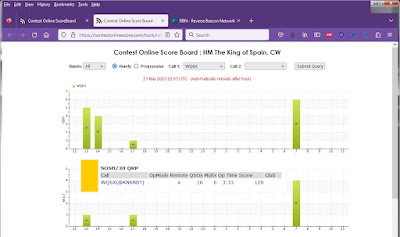each event; altho All Asian Ssb events leave me even MORE perplexed.
Throughout 2023 I have been dabbling in various approaches to running radiosport events QRP
(5-watts). While WQ6X has run a few QRP GiGs from W7AYT's QTH in the East Bay (EB) section,
the more successful QRP runs - such as the 1st-place (outside of the 7th-call area) in the recent 7QP QSO Party - have been accomplished by running WQ6X remotely from KN6NBT's QTH in Ramona (San Bernardino area of So. California), a location colloquially known as "Cliffside".
Space-WX conditions. Friday morning didn't look so good. Fortunately, 24-hours later things were MUCH improved. Unfortunately, for unknown reasons, I was unable to make QSOs on bands below 20-meters - Bummer Dewd! 10-meters was a near no-show, leaving all the WQ6X action to happen on 20 & 15 meters. On the other hand, while 10-meters was a ho-hummer at NX6T, the rest of the bands were right on!2 years ago, NX6T pulled-up stakes in Fallbrook, moving "Tower #1" to the Ramona hilltop location.
At 55' (it's lowest height), we have access to a 3-el Stepp-IR yagi, as well as a classic Mosley 2-el Mosley "Shorty-40". For 80-meters, a droopy coaxial double-bazooka makes North and Central America possible, and even at times, the NW tip of Africa (EA8 & D42).
Theoretically, working into Asia should be relatively easy - a mere "skip across the Pacific Pond" from the mountain-top Ramona QTH. Running JIDX Cw as a QRP entry put an amazing number of QSOs in the log. Last year,
A major secret to making high scores in All Asian events is to get used to running frequencies at afast clip. Wandering S&P JA's dutifully line-UP to work stations who can run frequencies effectively. Both mornings on the 40/80 there seemed to be a pipeline to Japan. While 10-meters was virtually
a no-show on Saturday, running as NX6T Sunday afternoon, a propagation DUCT opened to JA for about 45 minutes. When N6KI relieved me at 22:00z, I looked for that same propagation-duct from the Ramona QTH - NOTHING! Nevertheless, when it was all over, WQ6X/QRP managed to snap-up
a QRP 1st-Place; world-wide, no less. NX6T managed a comfortable 1st place for the Multi-Single category.
DiD YOU work the All Asian contest?
How many Asian prefixes ended up in YOUR LoG?
.Jpg)







.Jpg)




.Jpg)
